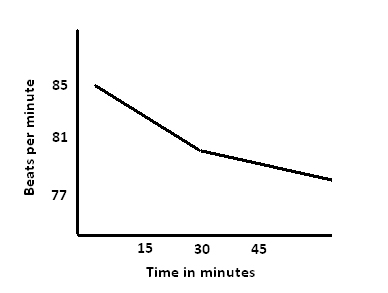Kill lecture boredom through science
One way to think about public speaking is that’s it’s a game of attention. You have to keep people’s attention in order for them to learn anything from you. Lose their attention and it’s game over.
But most things that earn people’s attention are annoying. I could stand at the front of the room and set off the fire alarm every 5 minutes. They’d hate me, but boy, I’d sure have their attention. What we really want is positive attention.
One great nugget comes from Bligh’s book, What’s the use of lectures? There he explains exactly how long most people’s attention spans probably are. This chart shows an audience’s average heart rate over time:

This chart show exactly what happens while you’re speaking – people’s heart rates decline. They are getting bored and there is a break point at about 25 minutes.
This data comes from a small study of 16 students, over four different lectures. Not a huge study, but the best data I’ve seen on boredom (See page 51 of Bligh’s book)
What does this mean? Two things:
- 20 to 30 minutes is a sweet spot amount of time for lectures (No surprise TED and GEL use this format).
- If you go longer, do something different every 20 minutes to regain people’s attention.
The problem is, most speakers don’t know how to do anything but straight on, monotone, bullet list heavy, lecturing. We do not have another thing we know how to do in front of an audience.
The ideal thing would be go interactive. Have the audience do an exercise, answer a question, watch a movie, or move their bodies in some way every 20 minutes. But this requires planning and skills most speakers do not have.
If you are asked to speak longer than 20 minutes, plan breakpoints. Stop every 20 or 25 minutes and ask the audience if they have a question. Or better yet, ask them a question for a show of hands. Give them a challenging problem to solve, or show a short film, do a dance, or move to a new spot on the stage. Anything to help reset their attention cycles.
April 8th, 2009 at 10:31 am
[…] How to fix boring lectures. Mobilizers, mission presenters, keynote speakers, pay attention! […]
April 13th, 2009 at 3:09 am
[…] people can maintain concentration beyond 20 minutes, when listening to a one-way monologue talk, as Speaker Confessions explains. A recent BBC TV program on rhetoric claimed that Dr Billy Graham rarely spoke for more […]
April 13th, 2009 at 7:24 am
[…] attention span of someone listening to a lecture (or sermon as the case may be). It’s called Kill lecture boredom through science from the Speaker Confessions blog. The results are based on a very small study of monitoring heart […]
September 17th, 2009 at 9:40 am
[…] attention span of someone listening to a lecture (or sermon as the case may be). It’s called Kill lecture boredom through science from the Speaker Confessions blog. The results are based on a very small study of monitoring heart […]
May 4th, 2010 at 7:51 pm
As a pastor of a small country church, I’ve found this to be the same. If I talk for a long time (more than about 25 minutes) people actually get to the stage where they can’t remember a single thing I’ve said. I try to keep it to 20 minutes and also use youtube videos or pictures and sometimes sound effects to keep people interested. Often preachers have an illustration for every point they make – so now I try to use youtube or similar for my illustrations. It certainly makes for more interesting sermons.